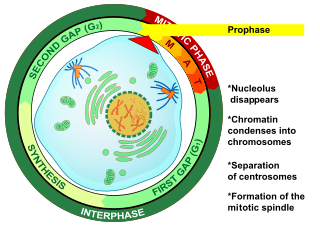
Prophase is the first stage of cell division in both mitosis and meiosis. Beginning after interphase, DNA has already been replicated when the cell enters prophase. The main occurrences in prophase are the condensation of the chromatin reticulum and the disappearance of the nucleolus.

The synaptonemal complex (SC) is a protein structure that forms between homologous chromosomes during meiosis and is thought to mediate synapsis and recombination during meiosis I in eukaryotes. It is currently thought that the SC functions primarily as a scaffold to allow interacting chromatids to complete their crossover activities.

Synapsis is the pairing of two chromosomes that occurs during meiosis. It allows matching-up of homologous pairs prior to their segregation, and possible chromosomal crossover between them. Synapsis takes place during prophase I of meiosis. When homologous chromosomes synapse, their ends are first attached to the nuclear envelope. These end-membrane complexes then migrate, assisted by the extranuclear cytoskeleton, until matching ends have been paired. Then the intervening regions of the chromosome are brought together, and may be connected by a protein-RNA complex called the synaptonemal complex. During synapsis, autosomes are held together by the synaptonemal complex along their whole length, whereas for sex chromosomes, this only takes place at one end of each chromosome.
Meiotic drive is a type of intragenomic conflict, whereby one or more loci within a genome will affect a manipulation of the meiotic process in such a way as to favor the transmission of one or more alleles over another, regardless of its phenotypic expression. More simply, meiotic drive is when one copy of a gene is passed on to offspring more than the expected 50% of the time. According to Buckler et al., "Meiotic drive is the subversion of meiosis so that particular genes are preferentially transmitted to the progeny. Meiotic drive generally causes the preferential segregation of small regions of the genome".

Deleted in azoospermia-like is a protein that in humans is encoded by the DAZL gene.

Deleted in azoospermia 1, also known as DAZ1, is a protein which in humans is encoded by the DAZ1 gene.

Deleted in azoospermia protein 3 is a protein that in humans is encoded by the DAZ3 gene.

TRIP13 is a mammalian gene that encodes the thyroid receptor-interacting protein 13. In budding yeast, the analog for TRIP13 is PCH2. TRIP13 is a member of the AAA+ ATPase family, a family known for mechanical forces derived from ATP hydrolase reactions. The TRIP13 gene has been shown to interact with a variety of proteins and implicated in a few diseases, notably interacting with the ligand binding domain of thyroid hormone receptors, and may play a role in early-stage non-small cell lung cancer. However, recent evidence implicates TRIP13 in various cell cycle phases, including meiosis G2/Prophase and during the Spindle Assembly checkpoint (SAC). Evidence shows regulation to occur through the HORMA domains, including Hop1, Rev7, and Mad2. Of note, Mad2's involvement in the SAC is shown to be affected by TRIP13 Due to TRIP13's role in cell cycle arrest and progression, it may present opportunity as a therapeutic candidate for cancers.

Meiotic recombination protein DMC1/LIM15 homolog is a protein that in humans is encoded by the DMC1 gene.

MutS protein homolog 4 is a protein that in humans is encoded by the MSH4 gene.

Protein boule-like is a protein that in humans is encoded by the BOLL gene.

Meiotic recombination protein REC8 homolog is a protein that in humans is encoded by the REC8 gene.

Synaptonemal complex protein 1 is a protein involved in the synaptonemal complex during meiosis, that in humans is encoded by the SYCP1 gene.

HORMA domain-containing protein 1 (HORMAD1) also known as cancer/testis antigen 46 (CT46) is a protein that in humans is encoded by the HORMAD1 gene.

The meiotic recombination checkpoint monitors meiotic recombination during meiosis, and blocks the entry into metaphase I if recombination is not efficiently processed.

Homeobox protein NOBOX, also known as newborn ovary homeobox protein, is a protein that in humans is encoded by the NOBOX gene. The official symbol (NOBOX) and the official full name are maintained by the HGNC. The NOBOX gene is conserved in chimpanzee, Rhesus monkey, cow, mouse, and rat. There are 175 organisms that have orthologs with human gene NOBOX. It is capable of regulating other genes that are important in the development of follicles. Follicles do not develop and oocytes decrease in its absence which lead to infertility.

Structural maintenance of chromosomes protein 1B (SMC-1B) is a protein that in humans is encoded by the SMC1B gene. SMC proteins engage in chromosome organization and can be broken into 3 groups based on function which are cohesins, condensins, and DNA repair.SMC-1B belongs to a family of proteins required for chromatid cohesion and DNA recombination during meiosis and mitosis. SMC1ß protein appears to participate with other cohesins REC8, STAG3 and SMC3 in sister-chromatid cohesion throughout the whole meiotic process in human oocytes.

PR domain zinc finger protein 9 is a protein that in humans is encoded by the PRDM9 gene. PRDM9 is responsible for positioning recombination hotspots during meiosis by binding a DNA sequence motif encoded in its zinc finger domain. PRDM9 is the only speciation gene found so far in mammals, and is one of the fastest evolving genes in the genome.

Stromal antigen 3 is a protein that in humans is encoded by the STAG3 gene. STAG3 protein is a component of a cohesin complex that regulates the separation of sister chromatids specifically during meiosis. STAG3 appears to be paramount in sister-chromatid cohesion throughout the meiotic process in human oocytes and spermatocytes.

Protamine 2 is a protein that in humans is encoded by the PRM2 gene.



















